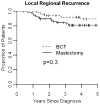Young women with locally advanced breast cancer who achieve breast conservation after neoadjuvant chemotherapy have a low local recurrence rate
- PMID: 21944346
- PMCID: PMC4167782
Young women with locally advanced breast cancer who achieve breast conservation after neoadjuvant chemotherapy have a low local recurrence rate
Abstract
Women with locally advanced breast cancer (LABC) who are breast conservation (BCT) candidates after neoadjuvant chemotherapy have the best long-term outcome and low local-regional recurrence (LRR) rates. However, young women are thought to have a higher risk of LRR based on historical data. This study sought to evaluate LRR rates in young women who undergo BCT after neoadjuvant chemotherapy. We identified 122 women aged 45 years or younger with American Joint Committee on Cancer (AJCC) Stage II to III breast cancer, excluding T4d, treated with neoadjuvant chemotherapy from 1991 to 2007 from a prospective, Institutional Review Board-approved, single-institution database. Data were analyzed using Fisher eExact test, Wilcoxon tests, and the Kaplan-Meier method. Median follow-up was 6.4 years. Fifty-four (44%) patients had BCT and 68 (56%) mastectomy. Forty-six per cent were estrogen receptor-positivity and 28 per cent overexpressed Her2. Mean pretreatment T size was 5.6 cm in the BCT group and 6.7 cm in the mastectomy group (P = 0.04). LRR rates were no different after BCT compared with mastectomy (13 vs 18%, P = 0.6). Higher posttreatment N stage (P < 0.001) and AJCC stage (P = 0.008) were associated with LRR but not pretreatment staging. Disease-free survival was better for patients achieving BCT, with 5-year disease-free survival rates of 82 per cent (95% CI, 69 to 90%) compared with 58 per cent (95% CI, 45 to 69%) for mastectomy (P = 0.03). Young women with LABC who undergo BCT after neoadjuvant chemotherapy appear to have similar LRR rates compared with those with mastectomy. This suggests that neoadjuvant chemotherapy may identify young women for whom BCT may have an acceptable risk of LRR.
Figures


Similar articles
-
Loco-regional control after neo-adjuvant chemotherapy and conservative treatment for locally advanced breast cancer patients.Breast J. 2014 Jul-Aug;20(4):381-7. doi: 10.1111/tbj.12277. Epub 2014 Jun 2. Breast J. 2014. PMID: 24890310 Clinical Trial.
-
Local-regional control according to surrogate markers of breast cancer subtypes and response to neoadjuvant chemotherapy in breast cancer patients undergoing breast conserving therapy.Breast Cancer Res. 2012 May 23;14(3):R83. doi: 10.1186/bcr3198. Breast Cancer Res. 2012. PMID: 22621334 Free PMC article.
-
Comparison of risk of local-regional recurrence after mastectomy or breast conservation therapy for patients treated with neoadjuvant chemotherapy and radiation stratified according to a prognostic index score.Int J Radiat Oncol Biol Phys. 2006 Oct 1;66(2):352-7. doi: 10.1016/j.ijrobp.2006.04.046. Epub 2006 Aug 2. Int J Radiat Oncol Biol Phys. 2006. PMID: 16887286
-
Overview of resistance to systemic therapy in patients with breast cancer.Adv Exp Med Biol. 2007;608:1-22. doi: 10.1007/978-0-387-74039-3_1. Adv Exp Med Biol. 2007. PMID: 17993229 Review.
-
Breast-conserving treatment after neoadjuvant chemotherapy in large breast cancer.Breast Cancer. 2002;9(1):20-5. doi: 10.1007/BF02967542. Breast Cancer. 2002. PMID: 12196717 Review.
Cited by
-
Locally advanced breast cancer treated with neoadjuvant chemotherapy: Is breast-conserving surgery feasible?Ann Med Surg (Lond). 2020 Dec 26;62:95-97. doi: 10.1016/j.amsu.2020.12.039. eCollection 2021 Feb. Ann Med Surg (Lond). 2020. PMID: 33520202 Free PMC article.
-
Optimizing surgical margins in breast conservation.Int J Surg Oncol. 2012;2012:585670. doi: 10.1155/2012/585670. Epub 2012 Dec 9. Int J Surg Oncol. 2012. PMID: 23304479 Free PMC article.
-
Proteogenomic characterization of invasive breast tumors in young women.NPJ Breast Cancer. 2025 Aug 18;11(1):94. doi: 10.1038/s41523-025-00793-0. NPJ Breast Cancer. 2025. PMID: 40826002 Free PMC article.
-
Locally advanced breast cancer: breast-conserving surgery and other factors linked to overall survival after neoadjuvant treatment.Front Oncol. 2023 Nov 6;13:1293288. doi: 10.3389/fonc.2023.1293288. eCollection 2023. Front Oncol. 2023. PMID: 38023121 Free PMC article.
-
Survival Outcomes of Breast-Conserving Surgery Versus Mastectomy in Locally Advanced Breast Cancer Following Neoadjuvant Chemotherapy: A Meta-Analysis.Technol Cancer Res Treat. 2024 Jan-Dec;23:15330338241265030. doi: 10.1177/15330338241265030. Technol Cancer Res Treat. 2024. PMID: 39043051 Free PMC article.
References
-
- Veronesi U, Cascinelli N, Mariani L, et al. Twenty-year follow-up of a randomized study comparing breast-conserving surgery with radical mastectomy for early breast cancer. N Engl J Med. 2002;347:1227–32. - PubMed
-
- Xiong Q, Valero V, Kau V, et al. Female patients with breast carcinoma age 30 years and younger have a poor prognosis: the M.D. Anderson Cancer Center experience. Cancer. 2001;92:2523–8. - PubMed
-
- Anders CK, Hsu DS, Broadwater G, et al. Young age at diagnosis correlates with worse prognosis and defines a subset of breast cancers with shared patterns of gene expression. J Clin Oncol. 2008;26:3324–30. - PubMed
MeSH terms
Grants and funding
LinkOut - more resources
Full Text Sources
Medical
Research Materials
Miscellaneous
